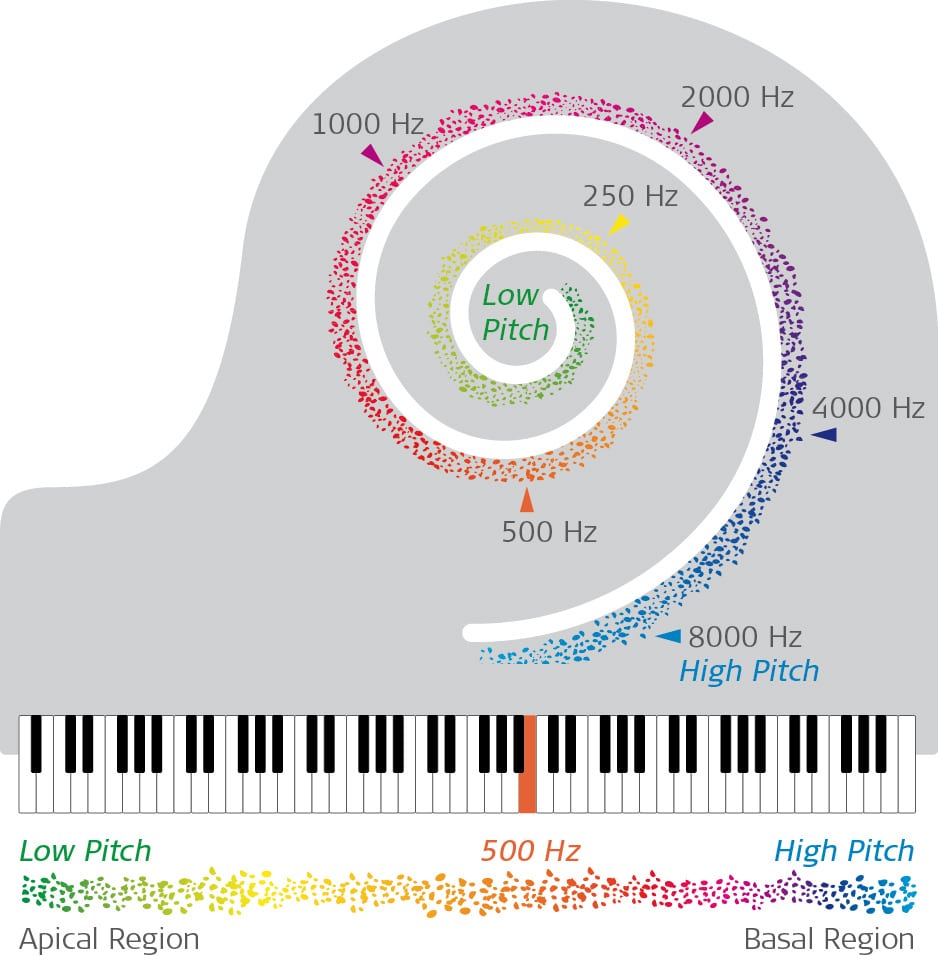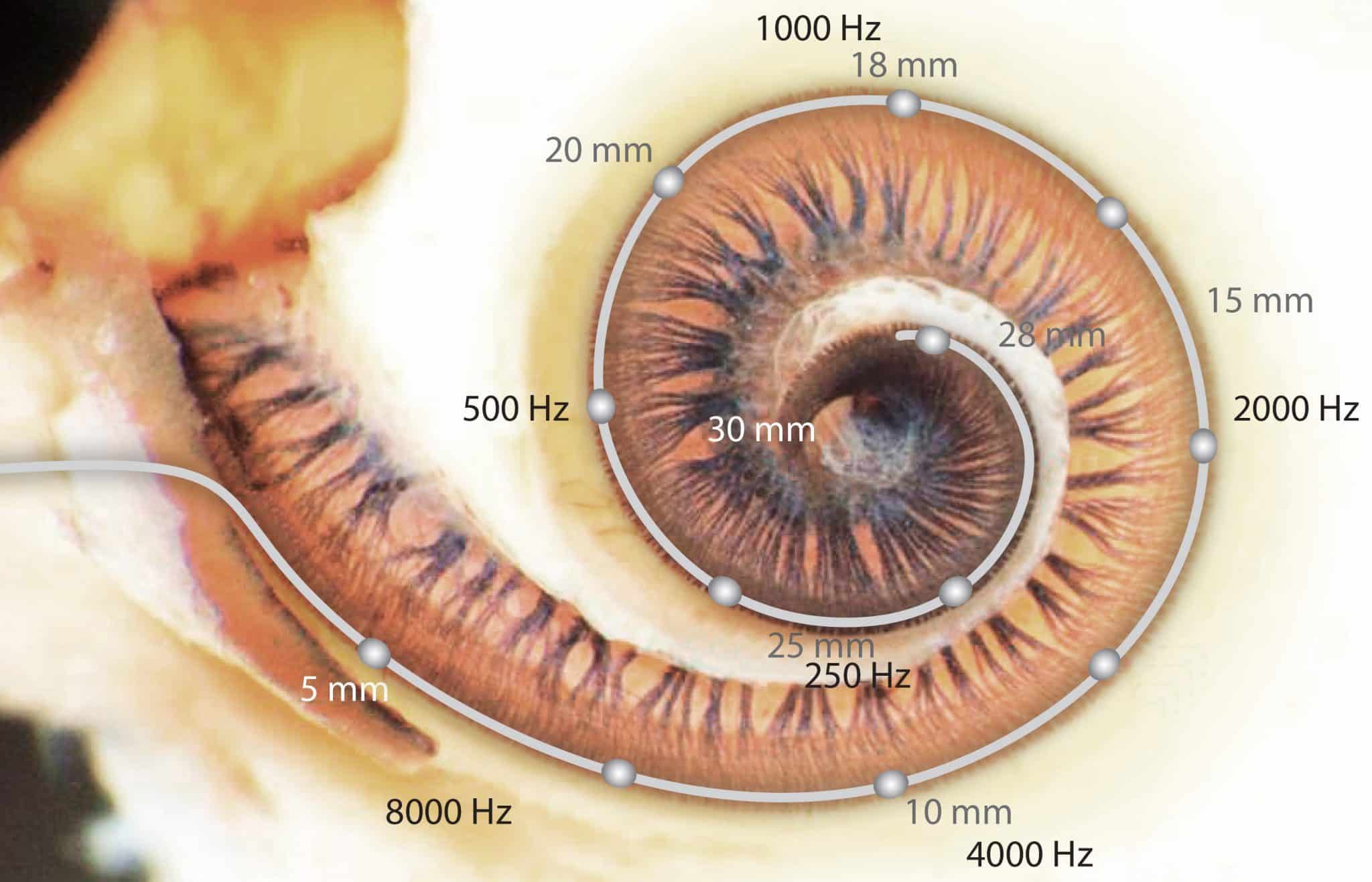
MED-EL
Published Jul 08, 2015
Low Frequency Sounds with a Cochlear Implant
For someone who’s received a cochlear implant in their teen or adult years, their hearing is likely to change during the first few months after activation. Many recipients will say that the low frequency sounds start to get fuller, deeper, and more natural. But why does this change happen?

It happens because the brain itself changes and adapts to the low frequency sounds from the cochlear implant. But the speed and effectiveness of adapting isn’t the same for every cochlear implant design, and longer electrode arrays can make it quicker and more accurate. Here’s why.
It’s Called Tonotopy
Hearing all starts with how the ear sends sound information to the brain. The cochlea, where the electrode array is inserted, has thousands of tiny hair cells that are each responsible for perceiving a different frequency of sound.
The high-frequency area is at the beginning of the cochlea, and the low-frequency area is at the end. If one of these hair cells is stimulated it sends that corresponding information to the brain: your cochlea tells your brain “you’re hearing a 300 Hz sound now”. Scientists call this tonotopy, and here’s what it looks like:

The cochlea is like a curled-up piano.
A person with normal hearing will be able to hear the actual range of sound because all their hair cells are intact. But for someone with a cochlear implant the only way to stimulate sounds is by stimulating the hair cells responsible for the specific frequency—and for low-frequency sounds that means going deep into the cochlea.
Mismatch: Lost in Translation
After the audio processor’s activation, a recipient often will say “wow, I can hear!” and then follow that up with “it sounds like Mickey Mouse, really weird and high pitched”. This happens because there’s sometimes a mismatch between the sound signals that a cochlear implant sends to the cochlea and how their brain understands them.
For example, let’s say an electrode array’s deepest contact wants to send the signal for a low 150 Hz sound. But, if the array is short and can only reach into the part of the cochlea responsible for a high 300 Hz sound then the brain will hear 300 Hz each time it goes off—not 150 Hz. This is why sounds could initially seem much higher.
Low Frequency Sounds with Longer Electrode Arrays
So why is it only “initially”? It’s because the brain’s hearing isn’t written in stone but is instead like plastic: it’s able to fine-tune itself and overcome the mismatch between the low-pitch incoming signal and the high-pitch area of the cochlea that’s stimulated.
The amount of mismatch depends on how deep (or not deep) the electrode array is inserted. A longer electrode array can be inserted deeper into the cochlea. That means that longer electrode arrays are able to get closer to the hair cells responsible for the 150 Hz sounds and can therefore stimulate 150 Hz more accurately with less mismatch to initially overcome.

An example of where an electrode array’s contacts can stimulate the cochlea.
In a study of 14 cochlear implant recipients whose deepest electrode contact sent the signal for a specific frequency of sound, newer cochlear implant recipients said on average that it sounded like a 666.9 Hz sound and more experienced recipients said on average that it sounded like a 381.8 Hz sound.McDermott, H., Sucher, C., Simpson, A. (2009) Electro-Acoustic Stimulation. Audiology & Neurotology 14(1):2- doi: 10.1159/000206489[1]
Their brain has started interpreting the cochlear implant’s stimulation differently, so that after some time an identical signal starts to sound lower in frequency.
Auditory Memory Might be Why Sounds Change
Scientists are currently trying to determine exactly why the brain is able to compensate for this mismatch, and their best guess right now is a concept called auditory memory. This means that for someone who lost their hearing after developing some listening and speaking skills, their brain compares what it hears with the cochlear implant to what it remembers hearing in the past. Over time this past memory starts to influence the present hearing until sounds across all frequencies, especially the low ones, start to line up closer to natural hearing.
But this change isn’t perfect and there are some mismatches that can’t be overcome: a short electrode array that goes only to the 1000 Hz part of the cochlea just isn’t likely to ever be able to accurately replicate a 150 Hz tone. And everybody’s hearing will be different so it can take time—days, weeks, months, even years—and some recipients will never completely overcome the mismatch.
That’s why, since the very first MED-EL electrode array we’ve always dedicated ourselves to developing truly long electrode arrays, those which can reach deep into the cochlea and cover the widest range of frequencies. We know that every cochlea is unique and have created the widest range of electrode arrays with lengths to best match cochleae of all sizes. What that means is that your brain might have to do less work to overcome a potential mismatch, leading you to hear the right sounds faster.
References
-
[1]
McDermott, H., Sucher, C., Simpson, A. (2009) Electro-Acoustic Stimulation. Audiology & Neurotology 14(1):2- doi: 10.1159/000206489
References

MED-EL
Was this article helpful?
Thanks for your feedback.
Sign up for newsletter below for more.
Thanks for your feedback.
Please leave your message below.
Thanks for your message. We will reply as soon as possible.
Send us a message
Field is required
John Doe
Field is required
name@mail.com
Field is required
What do you think?
© MED-EL Medical Electronics. All rights reserved. The content on this website is for general informational purposes only and should not be taken as medical advice. Contact your doctor or hearing specialist to learn what type of hearing solution suits your specific needs. Not all products, features, or indications are approved in all countries.

MED-EL

MED-EL


